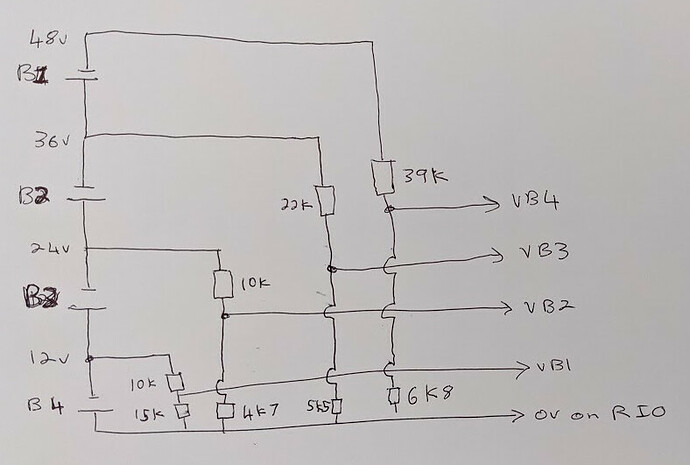Is it possible to take the individual analog value of a set of batteries (12 Vdc in series, example 4 batt), through voltage dividers with a single RIO?. What would be the correct connection diagram?
Yes.
I have done that and a few other customers have done that.
Two 1k ohm resistors will tap it down to a safe voltage (remember, at full charge you can see over 14.5ish volts). Just do some math in the scaling or Node-RED or in the end result to get very accurate battery voltage.
I will draw out a diagram as soon as I can, but I am not sure what you mean about 4 batteries… Do they all have a common ground?
Thanks for your prompt reply Ben. I think a drawing would clarify more things.

The RIO channels for analog input share a common connection internally, so you would need to measure the voltage (with a voltage divider circuit to keep it under 10VDC) with a common reference. This would nominally measure 12, 24, 36, and 48 volts on each channel.
Select high value resistors to minimize the parasitic drain on the cells, particularly because one battery will be connected to all the divider circuits and will go out of balance sooner.
Thanks for the diagram @nextcontrol very helpful.
As @philip said, all the voltage inputs on the RIO have a common ground, so you will need to bring the ground of Batt4 to the RIO only.
All the others will be voltage taps from there.
I have run some rough numbers to get you started. I have assumed a max charged battery voltage of 15v since I don’t know the specs of the charger you using.
The most important thing is that you keep the max voltage going to the RIO under 10v at all times.
In my example here, I have said a max voltage of 9v into the RIO for a battery voltage of 15v on each battery.
Of course, when you hook this up check each battery tap with a meter before you connect it to the RIO.
You will need to do some math in Node-RED or your strategy or what every you are using to monitor the actual numbers.
If you want to play around with the numbers, I like this calculator here:
Thanks Beno and Philip, the answer is very clear
Beno,
Sure would be nice to have a Battery voltage analog monitor card…been wanting this for lets see, ages.
It would have scaling for 6, 12, 24, 36, and 48 volts DC, actual range would be 7.5, 15, 30, 45, and 72.5. It would be all isolated channels.
Wouldn’t a couple of SNAP-AIVRMS modules work for you? Same wiring as above without the resistors, accuracy is only 0.2 volts though.
OP wanted to use the RIO, smaller and cheaper than a controller with modules is my guess.
You are correct if they have a SNAP controller or EB in that location, but for monitoring a small remote battery bank, the RIO would be most cost effective solution for sure.
Accuracy is the problem. Consider the fact that charge range of a 12 volt battery is about 4 volts, and in that range, the accuracy is only about 5-6% and that assumes perfect resistors.
Also consider that the accuracy of the float voltage needs to be better than 25mV if you want your batteries to last 5+ years. I have batteries that have last more than 10 years and they were not expensive industrial types, I got them from Battery Clerk…
Float voltage and temperature and depth of discharge are the main problems with batteries in general and especially long term standby batteries.
I also decided and found to be true, that the extended runtime (external add-on) UPS units should have the internal batteries removed. If not, the charge circuit float voltage will be based on the internal set and the external batteries will end up being undercharged and have incorrect float voltage. The internal batteries will also be over worked and fail much sooner, causing drain from the external batteries to the internal batteries. There is always voltage drop on connectors and even on terminals, much less the cable itself. When you are discussing 12v batteries, mVs are a big deal.
While 100% correct, lets not loose track of what the task is… RIO is simply a battery monitor, not a charge controller. As you have pointed out, there is a BIG difference between the two.
The job is just to give a rough go/no go on the battery bank.
As I like to say, “Don’t let perfect get in the way of good”.
Is RIO the perfect charge controller? No, but it is a good monitor.

